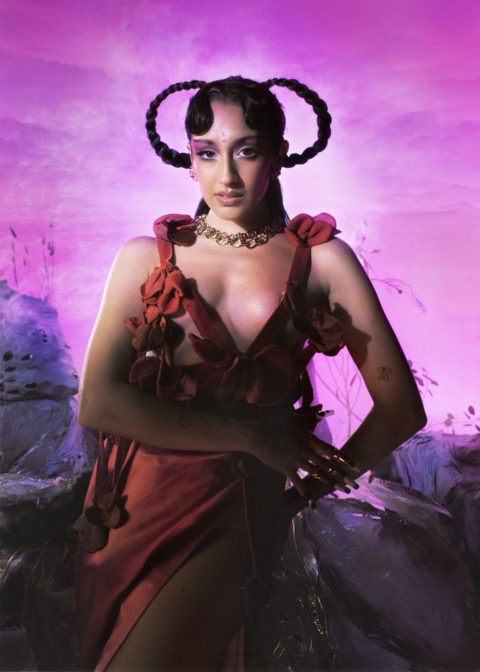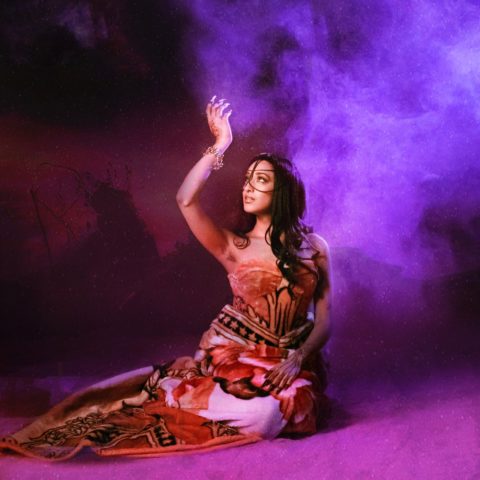The soul singer is welcoming an era of rebirth through her imaginative new album “Asha’s Awakening.”
I can’t help but smile at Raveena Aurora’s response when I ask her what piece of clothing she holds close to her heart. There’s an endearing quality behind her resolve to give me a sincere answer, and her thought process demonstrates how the delicate nature of her artistry extends to her everyday demeanor. In a world that often measures time with metrics of productivity, the artist welcomes you to slow down.
During our Zoom call, the Indian-American musician, currently located in Los Angeles, takes a moment to rummage through her colourful clothing collection. I hear the sound of hangers lightly clanging as she combs through her closet, finally reaching the floral pink dress she wore in the music video for her 2019 song “Mama,” a blissful ode to her mother and grandmother. Like any great sundress, “it carries you through a lot of different seasons and wholesome moments in your life,” she explains.
With honeyed vocals and escapist imagery, the 27-year-old makes music for venturing into unknown dimensions. Take her new album, Asha’s Awakening, which is set in a mythical galaxy of her own making. Released on February 11, the project guides listeners into a vibrant world inspired by Indian folklore and imagined by Raveena over the past three years.
Asha’s Awakening follows the titular Punjabi princess Asha as she travels space and time on a journey of self-discovery. Complete with fairy-tale-like visuals, songs are infused with Raveena’s signature whimsical sound while exploring topics of love, loss, destruction and healing.
Blending Bollywood influences with Western sounds like R&B, the album contains a myriad of moods. Upbeat songs like “Rush” and “Secret” are sultry dance anthems, while introspective tracks such as “Time Flies” and “Love Overgrown” tap into the complexities of growing up and experiencing heartbreak.
Raveena is seemingly most comfortable in a state of emotional vulnerability. “I’ve found it’s very brave to be soft,” she tells me. In her world, sensitivity, self-expression and spirituality go hand in hand. And clearly, she’s on to something. Below, Raveena (heading on tour in April) talks about using style as a form of escapism, entering an era of rebirth and cultivating a superpower through stillness.

Do you have a beauty philosophy?
My beauty philosophy is embracing inner and natural beauty. I feel the most beautiful when I’m in nature: when I have no makeup on, when I’m treating my body right, when I feel well-hydrated and just in touch with the earth.
What’s one piece of jewelry or clothing item that’s especially meaningful to you?
I’m actually going to look through my closet. [Laughs] Sorry, one second. There are some pieces that I’ve worn in music videos that are really special and I still keep them. I always go back to the dress that I wore in the “Mama” video. It’s a great sundress that has lasted me a couple of years now. It’s really special to me because I got to be in this very wholesome video with my mom and my grandma. And it was a rare moment where I didn’t have a stylist and I just kind of found the dress on my own.
The right sundress can hold such good energy.
Yes, exactly. And it carries you through a lot of different seasons and wholesome moments in your life.
What would you name this era of your life?
I would name it “rebirth of self.” I think I’m stepping into a more confident, sensual and adult version of myself. I’m figuring out what that looks like: what parts I want to honour and keep from my younger self, and what parts I want to rebirth…I’m going through a lot of self-discovery and I’m trying on different personas and parts of myself to see what feels comfortable.
You’ve described your younger self as introverted, but you employ bright, maximalist visuals into your art. How did you develop such an outgoing, bold aesthetic?
It’s definitely inspired by Bollywood. It’s such a maximalist and colourful genre of film. If you watch any of it, [you can see] it’s a true celebration of life and a celebration of something larger than life and ornate and grand. I found so much beauty in that growing up.
Your colourful makeup looks often include face gems and body art. What has your makeup journey been like over the years?
I didn’t wear much makeup until I started doing music professionally about four years ago. And I was very hesitant at first, but then I began experimenting with makeup and working with artists who really treat it like an art form, like Ana Takahashi and Amrita Mehta. These artists have taught me that there is a whole other kind of artistic expression [through makeup].
How has your style evolved with your artistry?
Having the opportunity to wear incredible pieces from such a range of designers has really made me fall in love with the artistry that all these designers bring and the visions they have. I’ve found there are parallels between fashion and music: I love designers that explore fantasy, that want to break tradition and that want to experiment. Over the years, my style has become about escapism and creating pictures and visions that are larger than life.
In Asha’s Awakening, you channeled your Punjabi culture with imagery, Indian instruments and Hindi singing. What inspired you to base your album around this part of your identity?
This album was a deep dive into all the ways that South Asian music intersected with all these genres that I love, like R&B, soul, psychedelic rock and jazz. I kind of felt a bit lost as a South Asian artist because we’re so underrepresented, and I feel like our sound within the diaspora is so scattered. The album is varied in genre and sound, but it’s this beautiful exploration of South Asian history and the ways it met with the West.

You’re known for your soft-spoken demeanor and aura of tenderness. How do you find strength in softness?
I’ve found it’s very brave to be soft. Because I think that my softness is often misunderstood and it can be easy to criticize. Experiencing that over and over again has just made me realize how much I really believe that this world is gentle and beautiful, even if our reality doesn’t reflect that all the time. I think there is a dimension of this planet that is very pure and protected by the universe. I really believe in that, and I want to inspire other people to believe in that as well. It’s not an easy thing to do.
How do you stay connected to your inner child?
By allowing myself to imagine and dream. I think this album was really a reflection of that inner child in the way that there was this whole character and story. I allowed myself to get lost in fantasy. Letting myself play, dream and be in nature is really important in protecting my inner child.

What’s your personal superpower?
Definitely meditation. It grounds me in this way that makes me feel pretty powerful, like I can do anything. It’s very easy to spiral when you work in entertainment, but I think that when you have something like meditation, it really grounds you to what’s important.
You concluded your album with a 13-minute guided meditation, and you lead meditations at your shows as well. What made you want to incorporate the practice into your music?
I think it’s just such a beautiful tool for people to have. I really want to give people the power of meditation. I’ve found that guided meditations were a great way for me to get into it when I was first starting to meditate and I didn’t really understand how to do it or what exactly I was supposed to be trying to feel. So if I can be a guide for people in that way, I think that’s a beautiful thing to offer beyond the music.
